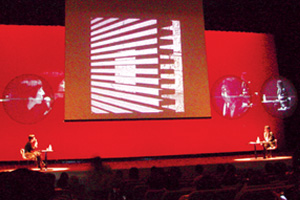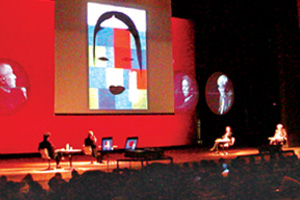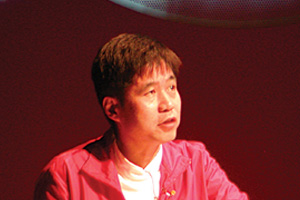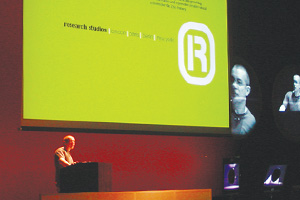|
|
 |
 |
 |
| Kengo Kuma (Japan), Kazuyo Sejima (Japan) |
 |
Mission and materiality
Kazuyo Sejima bends structural materials such as glass and steel into interior and exterior walls that house particular activities. From shopping at Prada to dining with guests on a home veranda, she seems inspired by the activities of a place. As she describes some of the process and consideration of international cultural projects, she brings life to hand-drawn art students sitting in a hallway peeking into the studios of musicians. Curators of the 21st Century Museum of Contemporary Art Kanazawa arrange an exhibition hall as one, two, three or more separate galleries.
Before showing examples of his own work, Kengo Kuma framed an architectural context by surveying digital designs since 1990. The "Blob Architecture" emerges from forms that can only be generated on a computer, such as Franko. Gehry's Guggenheim Museum Bilbao. In his own architecture, Kuma twists walls to become floors and flips floors to become ceilings. The reaction to this digital design direction begins around 1995 with a celebration on materialality. Building materials are used for both their communicative potential as well as their emotive qualities. The emphasis is on spaces experienced by a person but not easily described by a computer. Kuma shares examples of his work: a building hidden beneath a mountain, a small exhibit space made of blocks, an entire building made of bamboo.
The two architects concluded the session with discussions on architectural photography, the quality of materials and the phenomena of experiencing architecture. (TW)
|
 |
 |
 |
 |
 |
| Christopher Mount (USA), Kazumasa Nagai (Japan), Tadanori Yokoo (Japan), Masuteru Aoba (Japan) |
 |
The art of the poster
This dialogue featured Christopher Mount (USA), Kazumasa Nagai (Japan), Tadanori Yokoo (Japan), and MasuteruAoba (Japan). This lively group reviewed some of the most influential poster designers in Japan. Christopher Mount wished to provide "an outsider's view". The other three speakers are all powerful poster designers. They discussed the big names in Japanese poster design from the grandfather of the genre, Yusaku Kamekura, to the youngest, Makoto Saito.
They began with Yusaku Kamekura, showing the 1964 Tokyo Olympic Games posters, and the famous 1983 Hiroshima Appeals poster. Apparently, Kamekura had a love of skiing. Next in the chronological survey came Ikko Tanaka. Sadly, he has passed away, but not before he left a considerable mark on poster design in Japan. Yoshio Hayakawa was another remarkable Japanese poster designer remembered for richness of coulor vocabulary. Kazumasa Nagai critiqued his own work next, speaking about the meaning behind some of his more abstract symbolism.
Mitsuo Katsui's posters display "oriental mystery" which Yokoo says never fails to befuddle Western viewers. Shigeo Fukuda's unusual sense of humor and strong opinions set him apart from other poster designers, as with the "Victory" poster. Tadanori Yokoo declined to speak about his own work, asking instead that you feel and see it. Christopher Mount, however, took the challenge and gave a statement about Yokoo's use of symbolism and modernism. Keisuke Nagatomo was known for his poster for the French book, The Little Prince, as well as for a number of other posters including "The Assassinators".
Masuteru Aoba spoke about his work, showing us works like "The Real Weight of Peace" and "All Flesh is Grass". Shin Matsunaga made the everyday object rise to greatness in his posters, like the Shiseido Sun Oil poster. Koichi Sato is said to have cornered the market on gradients with his ethereal posters. Masatoshi Toda's posters showcase unusual photography with minimal but elegant design. And finally, Makoto Saito, a designer who makes whatever he pleases, all of it beautiful. Nearly all these designers aredetailed in the book "12 Japanese Masters" (cover by Ikko Tanaka), which can be found in the conference book shop. Together these designers prove that truly, "The Japanese people have eyes for beauty".(NR)
|
 |
 |
 |
Following your heart
Makoto Saito has a solo performance in this lecture, "Earth-Shattering
Graphic Design". He is a contemporary graphic designer who followed
an interesting path to Graphic Design, which he tell us about in this
talk. He began his career in the world of Art and Design intending to
be a painter. During his education, he ran across a photograph of the
research laboratory of the Bauhaus, and for some reason this very much
struck his fancy. He decided to learn about design. Saito figured that
design was most alive in big cities and industrial countries, so he decided
to move to Tokyo and go to the Nippon Design Center. He was not accepted,
however, so he took up teaching himself, while working for the Advertising/PR
department of a supermarket. From the beginning he felt very much apart
from the world of Design, but relished not compromising his beliefs for
money or popularity. Eventually, he was able to convince Kazumasa Nagai
to allow him into the Nippon Design Center where he would meet his future
client, president of Alpha Cubic. He fought not to become a part of consumerism
while making a living. Saito then showed us slides of his work, telling
us about each. He concluded that designers should not give up their beliefs,
always staying open to new things and never ceasing to study and learn
and grow.(NR)
|
 |
 |
 |
Writer:Kosuke Ikehata/Norimitsu Korekata/Junko Sakamoto/Nobuko
Shimuta/Naoko Hasegawa/Osamu Hisanaga/Sakurako Muto/Naho Yoshioka/Helmut Langer/Maggie Hohle/Nicole Rechia/Trysh Wahlig/Gitte Waldman/Robert Zolna
Photographer:Yoshimitsu Asai/Yasuhiko Katsuta/Fumihiko Mizutani |
 |
|



